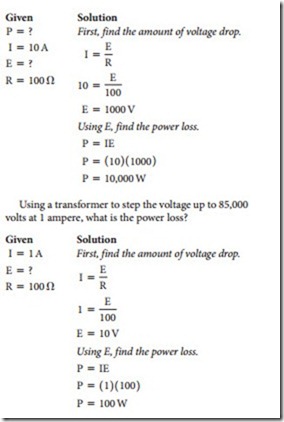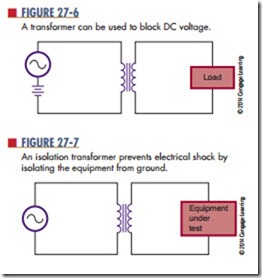applications
Transformers have many applications. Among them are stepping up and stepping down voltage and cur- rent, impedance matching, phase shifting, isolation, blocking DC while passing AC, and producing several signals at various voltage levels.
Transmitting electrical power to homes and industry requires the use of transformers. Power stations are located next to sources of energy, and electrical power must often be transmitted over great distances. The wires used to carry the power have resistance, which causes power loss during the transmission. The power is equal to the current times the voltage:
The amount of power lost, then, is proportional to the amount of resistance in the line. The easiest way to reduce power losses is to keep the current low.
Example: A power station produces 8500 volts at 10 amperes. The power lines have 100 ohms of resistance. What is the power loss of the lines?
How the transformer is wound determines whether it produces a phase shift or not. When both the primary and secondary windings are wound in the same direction, there is no phase shift of the output signal with respect to the input signal. If the secondary winding is wound in the opposite direction to the primary winding, the output waveform will be shifted 180° from the input waveform and represents a phase shift. The application determines how important the phase shift is (Figure 27-5).
If DC voltage is applied to a transformer, nothing occurs in the secondary once the magnetic field is established. A changing current in the primary winding is necessar y to induce a voltage in the secondary winding. A transformer can be used to isolate the secondary from any DC voltage in the primary (Figure 27-6).
An isolation transformer is used to isolate electronic equipment from 120-volts AC, 60-hertz power while it is being tested (Figure 27-7). The reason for using a transformer is to prevent shocks. Without the transformer, one side of the power source is connected to the chassis. When the chassis is removed from the cabinet, the “hot” chassis presents a shock hazard. This condition is more likely to occur if the power cord can be plugged in either way. A transformer prevents
connecting either side of the equipment to ground. An isolation transformer does not step up or step down the voltage.
An autotransformer is a device used to step up or step down applied voltage. It is a special type of transformer in which the primary and secondary windings are both part of the same core. Figure 27-8A shows an autotransformer stepping down a volt- age. Because the secondary consists of fewer turns, the voltage is stepped down. Figure 27-8B shows an autotransformer stepping up a voltage. Because the secondary has more turns than the primary, the voltage is stepped up. A disadvantage of the auto- transformer is that the secondary is not isolated from the primary. The advantage is that the auto- transformer is cheaper and easier to construct than a transformer.
A special type of autotransformer is a variable autotransformer, in which the load is connected to a movable arm and one side of the autotransformer (Figure 27-9). Moving the arm varies the turns ratio, producing a change in the voltage across the load. The output voltage can be varied from 0 to 130 VAC.
Questions
1. What are the applications of transformers?
2. How are transformers used in transmitting electrical power to the home?
3. How can a transformer produce a phase shift of the input signal?
4. Why are isolation transformers important when working on electronic equipment?
What is an autotransformer used for?





